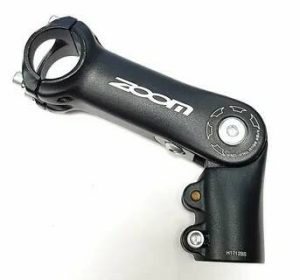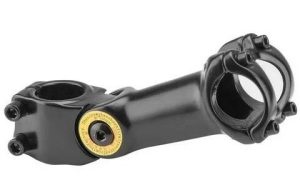The handlebar stem is a crucial part of a bicycle’s front end, as it connects the handlebars to the fork steerer tube, which is part of the bike’s front fork assembly. The stem allows the rider to adjust the height and angle of the handlebars, which can affect the bike’s handling and the rider’s comfort and posture. There are different types of handlebar stems available, including quill stems, threadless stems, and adjustable stems, each with their own advantages and disadvantages depending on the type of bike and the rider’s needs.
Types
There are several types of handlebar stem available for bicycles, each with its own unique features and benefits. Here are some of the most common types:
- Quill Stem: A quill stem is a traditional stem design that is commonly found on vintage bicycles. It is inserted into the steerer tube and tightened with a bolt at the top. The stem’s height and angle can be adjusted by loosening the bolt and raising or lowering the stem.
- Threadless Stem: A threadless stem is a more modern design that is commonly found on newer bicycles. It is mounted on the steerer tube with a clamp and tightened with bolts on the side. The stem’s height and angle can be adjusted by swapping out spacers or using a stem with a different rise or angle.
- Adjustable Stem: An adjustable stem allows the rider to adjust the stem’s angle and length on the fly. It is ideal for riders who want to fine-tune their riding position while riding.
- Aero Stem: An aero stem is designed to be more aerodynamic and is often used by road cyclists and triathletes. It is usually shorter and lower than a traditional stem and can improve the bike’s aerodynamics.
- Carbon Fiber Stem: A carbon fiber stem is lighter and stiffer than other types of stems, making it a popular choice for high-performance road bikes. However, it can be more expensive than other types of stems.
- Direct Mount Stem: A direct mount stem is a newer design that attaches directly to the fork crown instead of the steerer tube. It can provide a stiffer, more precise steering feel and is often used on mountain bikes and downhill bikes.
- Folding Stem: A folding stem is designed to be compact and easy to store or transport. It is ideal for commuters or riders who need to pack their bike into a small space.
These are some of the most common types of handlebar stem for bicycles. It’s important to choose the right type of stem for your bike and riding style to ensure optimal performance and comfort.
Quill Stem:
Quill stems have a distinctive look and are often preferred by cyclists who appreciate the classic aesthetic of older bikes. They also offer a more upright riding position than many modern stems, which can be more comfortable for some riders.
However, quill stems are becoming less common as newer bikes use threadless stems, which are easier to install and adjust. It can be more difficult to find replacement parts for quill stems, and they may not be compatible with newer bike components.
If you have an older bike with a quill stem, it’s important to make sure that it’s securely tightened and in good condition. You should also be aware that quill stems have a limited range of adjustment, so you may need to experiment with different stem lengths and handlebar positions to find the right fit for your body and riding style.
Threadless Stem:
Threadless stems are preferred by many cyclists because they offer several advantages over quill stems. For one, they are easier to install and adjust, since there is no need to thread the stem into the steerer tube. Additionally, they offer a wider range of adjustment, since stems can be swapped out quickly and easily to change the length or angle of the stem.
Threadless stems also tend to be stiffer and more rigid than quill stems, which can provide better handling and responsiveness. They are also more compatible with modern bike components, which are designed to work with threadless stems.
One downside of threadless stems is that they require a specific type of headset, known as a threadless headset, which can be more difficult to install than the older, threaded headsets used with quill stems. Additionally, threadless stems may not be as aesthetically pleasing to some cyclists, who prefer the classic look of a quill stem.
Overall, the choice between a quill stem and a threadless stem will depend on your personal preferences, the type of bike you have, and the type of riding you plan to do. If you’re not sure which type of stem is right for you, it’s always a good idea to consult with a professional at a bike shop who can help you make an informed decision.
Adjustable Stem:
Adjustable stems usually have a pivot point in the middle that allows the stem to be adjusted up or down, and some also allow for adjustment of the stem’s length. The angle of the stem can typically be adjusted between -10 and +60 degrees.
One advantage of an adjustable stem is that it can help you find the perfect fit for your body and riding style, which can improve your comfort and performance on the bike. However, adjustable stems are typically heavier than non-adjustable stems, which can affect the overall weight and handling of your bike.
Another consideration when using an adjustable stem is that it may not be as sturdy or secure as a non-adjustable stem, since it has more moving parts. For this reason, adjustable stems may not be suitable for aggressive riding styles or for riders who put a lot of stress on their bikes.
Overall, an adjustable stem can be a good option for riders who are looking for more flexibility in their riding position, but it’s important to weigh the advantages and disadvantages before making a decision. If you’re not sure whether an adjustable stem is right for you, it’s always a good idea to consult with a professional at a bike shop who can help you make an informed decision.
Aero Stem:
Aero stems typically have a low profile and a streamlined shape that minimizes the amount of air resistance that the stem creates. They may also have a unique shape that integrates with the bike’s frame and other components, such as the handlebars, to create a smooth, aerodynamic profile.
One disadvantage of an aero stem is that it may not be as adjustable as other types of stems. Since aerodynamics is the main concern, aero stems are often designed to be in a fixed position that cannot be easily adjusted. This means that you may need to experiment with different stem lengths and angles to find the perfect fit for your body and riding style.
Another consideration when using an aero stem is that it may not be as sturdy or durable as other types of stems. Since they are designed to be lightweight and aerodynamic, aero stems may be more prone to bending or breaking under stress.
Overall, an aero stem can be a good option for riders who are looking to improve their aerodynamics and maximize their speed on the bike. However, it’s important to consider the disadvantages and potential drawbacks before making a decision. If you’re not sure whether an aero stem is right for you, it’s always a good idea to consult with a professional at a bike shop who can help you make an informed decision.

Choosing the right stem for your bike
Choosing the right stem for your bike is important because it can affect the bike’s handling and your riding position. Here are some factors to consider https://www.buydo.eu when choosing a handlebar stem:
- Bike type: Different types of bikes require different types of stems. For example, road bikes typically use a shorter, lighter stem with a more aggressive angle, while mountain bikes typically use a longer, more sturdy stem with a more relaxed angle.
- Riding style: Your riding style can also affect your stem choice. If you prefer a more upright riding position, you may want a stem with a higher angle, while if you prefer a more aerodynamic position, you may want a stem with a lower angle.
- Handlebar size: The stem needs to be compatible with the size of your handlebars. The most common handlebar sizes are 25.4mm, 31.8mm, and 35mm.
- Steerer tube diameter: The stem needs to be compatible with the diameter of your bike’s steerer tube. The most common sizes are 1 inch and 1 1/8 inch.
- Length: The length of the stem can affect the bike’s handling and your riding position. A shorter stem can provide quicker handling, while a longer stem can provide more stability.
- Material: Stems are typically made from aluminum, carbon fiber, or steel. Aluminum is the most common material and is lightweight and durable, while carbon fiber is even lighter and can absorb more shock, but is more expensive.
- Brand and price: There are many different stem brands and price points available. It’s important to choose a reputable brand and a stem that fits within your budget.
- Seek professional advice: If you’re not sure which stem is best for your bike, it’s always a good idea to consult with a professional at a bike shop. They can help you choose the right stem based on your bike type, riding style, and other factors.
- Test ride different stems: Ultimately, the best way to choose the right stem for your bike is to try out different options and see which one feels the most comfortable and provides the best handling for your riding style and needs.
Ultimately, the best way to choose the right stem for your bike is to try out different options and see which one feels the most comfortable and provides the best handling for your riding style and needs. If you’re not sure which stem is best for your bike, it’s always a good idea to consult with a professional at a bike shop.
